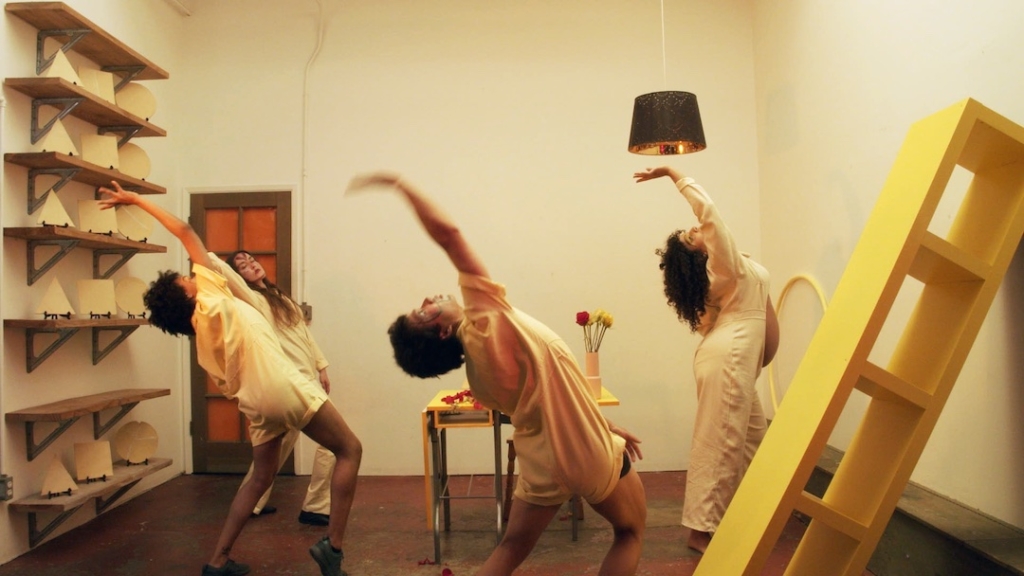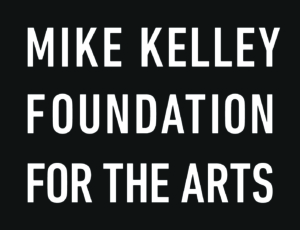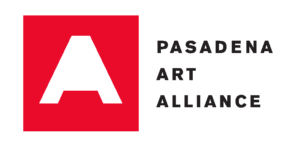Sofía Córdova, The Wreck and not the Story of the Wreck
May 11 – July 20, 2024
Opening: Saturday, May 11, 6-9pm

Sofía Córdova, GUILLOTINÆ WannaCry, Yellow: Break Room (still), 2019-21. Three-channel video, color, sound, 25 min.
JOAN presents The Wreck and not the Story of the Wreck, the first institutional solo exhibition in Los Angeles by Oakland- and Puerto Rico-based artist Sofía Córdova. The exhibition features two video installations from the artist’s GUILLOTINÆ WannaCry series, along with a newly commissioned installation with sculptural and text-based works. Córdova makes work that looks to science fiction as alternative history and considers climate capitalism’s deep entanglement with colonial erasure. The presentation at JOAN centers on her recent work on revolution—both historical and imagined—asking what are the gestational conditions necessary for collectively imagining and constructing a liberated future.
GUILLOTINÆ WannaCry is set in the near future and owes its title to the 2017 ransomware attack and its aptitude in naming a spirit of malaise. The series conceives of revolution as a speculative and indeterminate process. Through absurdity and nonlinearity, each act makes a different proposition for finding new ways to revolt by moving away from an authorial voice, and unsettling the notion of progressive time by creating synesthetic relationships through color.
The first act, GUILLOTINÆ WannaCry: YELLOW: Break Room (2019-21), resists historical tellings of revolution as individual-led events and looks instead at the collective to better understand who and what constitute organizing. Through a multichannel video work and a color-coded environment of readymades and objects, the work calls forward a near future where various possible ruptures—from global uprisings to the destabilization of governance and a series of climate-related events—subvert systems worldwide. The characters engage in conversations with historical revolution through the use of artifacts and archives, such as documentary images and film, sound bites of speeches, and found photographs ranging from the Black Panthers, Sandinistas, Russian Revolution, and the 2019 protests in the Caribbean and Latin America. They also study smaller acts of revolution: meetings, gatherings, and protests, and negotiate their distinct positions by citing reality TV, revolutionary leaders, poets and theorists including Adrienne Rich and Frantz Fanon. As the dancers move from solo choreographies to an improvised ensemble dance, the work calls forward the urgency of collective action in the long arc of organizing revolutions big and small. As a group, the dancers explore dance music’s liberatory dimensions as Córdova’s score moves from abrasive walls of sound to dance-inspired rhythms to sampled cut-ups of political speeches. Alongside the video, Córdova creates an immersive installation, which includes ceramic sculptures that mirror the dreamlike set inside Break Room, and further complicate the divisions between the digital space and its physical reproduction.
The second act after Yellow, GUILLOTINÆ WannaCry, GREEN: Savage Sauvage Salvaje (2022), tells histories of organizing by African fugitive slaves (cimarrones) and Indigenous people within the forest and jungle across the Caribbean and the Americas. The work presents resistance to colonialism and capitalist-patriarchy’s insistence on the intertwinement of the subaltern and natural resources in order to render them both exploitable. By confronting this position’s violent applications, GREEN: Savage Sauvage Salvaje argues that this conflation supports the extractive practices which have resulted in the climate crisis and long ago, the dual inventions of class and race. Threading throughout the video are fragments of texts drawn from historical accounts, poetry by Derek Walcott, Alice Walker, and William Carlos Williams, contemporary voices from the zeitgeist—reality TV, Internet, radio, and theory—and original text. For this particular score, Córdova (with collaborator Matthew Gonzalez Kirkland) makes reference to popular dance forms like reggaeton, bomba y plena, salsa, and free jazz to cement these forms of revolt as part of larger Black and Indigenous cultural processes. The video is presented within another color-coded setting with artifacts from filming locations, including leaves and lichens, 3D scans of seeds, and taxidermied birds. In its totality, the installation looks to multiple timelines, past and future, and approaches ‘wilderness’ as a collaborator in revolt and rejoicing.
This project expands on the artist’s explorations into zoological and botanical resistance to the environmental destruction by the human hand. It imagines a future landscape where flora and fauna survive and even thrive off pollution and other ravages, evolving in spite of harsh conditions. At the same time, as Córdova continually looks to Indigenous knowledge and proposes futures beyond colonial logics, she shows us the strength in collectivity and improvisation that comes in slow political movements. For the artist, the future is deemed as a site of possibility, as she asks us to witness, grieve, organize, and revolt together, and to keep asking: What forms of liberation lie in starting anew for those bodies whose lives have historically been predicated by the violence of disempowerment?
Upcoming programs and publication:
On Saturday, June 15 at 3pm, Sofía Córdova will be in conversation with poet and writer Raquel Gutiérrez. They will speak about the works in the exhibition and the artist’s research process, focusing on themes of collaboration, containment, and physical and conceptual borders.
JOAN will release Córdova’s scripts for GUILLOTINÆ WannaCry along with a series of drawings and photographs as part of Autograph Press. The publication is designed by The Rodina.
This exhibition is part of JOAN’s second Chapter of programming, which runs from April 2024 through July 2025, and brings together artists and collectives that explore varying communal structures of intervention and support, as experiments towards liberatory futures.
Sofía Córdova lives and works between her native Puerto Rico and Oakland, California. Her work considers science fiction, climate change, migration, and revolution within the matrix of class, gender, race, late capitalism and its evolving technologies. Córdova works in performance, video, sound, music, installation, photography, and sometimes taxidermy. She is one half of the music duo, XUXA SANTAMARIA, with Matthew Gonzalez Kirkland. Her work has been exhibited and performed nationally and internationally at The Whitney Museum of American Art, New York; Tufts University Galleries, Boston, Massachusetts; the Buffalo Institute for Contemporary Art, Buffalo, New York; the Arizona State University Museum, Tempe, Arizona; the Vincent Price Museum, Los Angeles; SFMOMA, the Wattis Institute, and Yerba Buena Center for the Arts (all San Francisco); as well as the Museo de Arte Contemporaneo, San Juan, Puerto Rico; Art Hub, Shanghai; and MEWO Kunsthalle, Memmingen, Germany. Córdova has participated in residencies at Eyebeam in New York; Headlands Center for the Arts and Mills College Museum in California; and the ASU Museum in Arizona; and choreographed performances for the SF Arts Commission and the Soundwave Biennial in San Francisco, and the Merce Cunningham Trust in New York. She is a recipient of a Fundación Ama Amoedo Grant, Creative Work Fund Grant, Artadia Award, and 2024 Creative Capital Award.
This project is supported, in part, by the Mike Kelley Foundation’s Organizational Support Grant and the Pasadena Art Alliance.



0